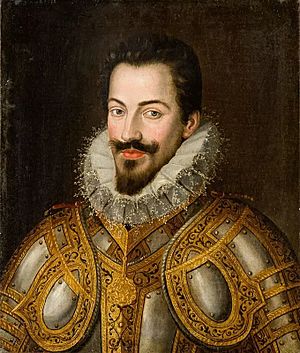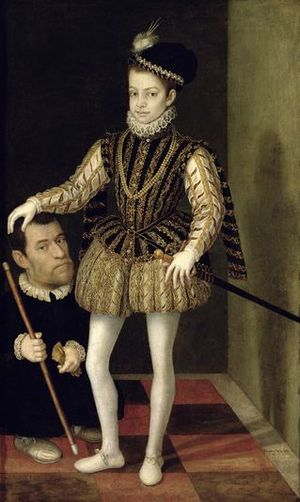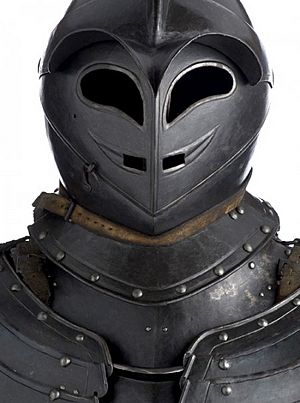Charles Emmanuel I, Duke of Savoy facts for kids
Quick facts for kids Charles Emmanuel I |
|
|---|---|

Portrait by Jan Kraeck
|
|
| Duke of Savoy | |
| Reign | 30 August 1580 – 26 July 1630 |
| Predecessor | Emmanuel Philibert |
| Successor | Victor Amadeus I |
| Born | 12 January 1562 Castle of Rivoli, Rivoli, Duchy of Savoy |
| Died | 26 July 1630 (aged 68) Savigliano, Duchy of Savoy |
| Spouse |
|
| Issue more... |
|
| House | Savoy |
| Father | Emmanuel Philibert, Duke of Savoy |
| Mother | Margaret of Valois, Duchess of Berry |
| Religion | Roman Catholicism |
| Signature | |
Charles Emmanuel I (born 12 January 1562 – died 26 July 1630) was a powerful ruler known as the Duke of Savoy. He led the Savoyard states for nearly 50 years, from 1580 until his death in 1630. People sometimes called him "the Great" because of his big plans. He also had a nickname, Testa d'feu, which means "Hothead," because he was very bold and loved military action.
Charles Emmanuel was ambitious and confident. He always wanted to make his duchy bigger. His main goal was to turn it into a powerful kingdom.
Contents
Biography: The Life of Charles Emmanuel I

Early Life and Education
Charles Emmanuel was born in the Castle of Rivoli in Piedmont. He was the only child of Emmanuel Philibert, Duke of Savoy and Margaret of France, Duchess of Berry. He became duke when his father passed away on August 30, 1580.
He was very smart and well-educated. Charles Emmanuel could speak Italian, French, Spanish, and even Latin. Even though he was short and had a hunchback, he was a skilled warrior.
Expanding His Territory
In 1588, Charles Emmanuel took advantage of a civil war in France. He took over the Marquisate of Saluzzo, which was under French protection. The new French king, Henry IV, demanded the land back. But Charles Emmanuel refused, and a war began.
He sent troops to Provence to help the Catholic League. However, a peace treaty in 1593 ended his plans there. The bigger conflict between France and Spain ended with the Peace of Vervins in 1598. This treaty did not solve the issue of Saluzzo.
After talking with Spain, Henry IV threatened war again. Finally, the Treaty of Lyon in 1601 settled things. Saluzzo became part of Savoy. In return, France received other territories like Bresse and Gex.
The Attack on Geneva (L'Escalade)
In 1602, Charles Emmanuel decided to attack the city of Geneva. On December 11, his soldiers tried a surprise night raid. They planned to climb the city walls in full armor.
However, a night watchman spotted them and raised the alarm. Geneva's citizens quickly defended their city. The attack was a huge failure for Savoy. Many of Charles Emmanuel's soldiers were killed or captured.
The heavy helmets worn by his troops became famous. They were called "Savoyard" helmets after this event. The people of Geneva still celebrate their victory every year. This festival is called L'Escalade.
Changing Alliances and Wars
In 1610, Charles Emmanuel made an alliance with France against Spain. This was called the Treaty of Bruzolo. But the French king, Henry IV, was assassinated. His wife, Marie de' Medici, did not recognize the treaty.
Charles Emmanuel continued his ambitious plans. In 1612, he tried to take over the Duchy of Montferrat. This led to a war against Venice, Tuscany, the Holy Roman Empire, and Spain. He had to give up his conquest.
Later, he got help from French troops to free Alba from the Spanish. In 1619, his son Victor Amadeus married Christine Marie of France, strengthening ties with France.
In 1625, Charles Emmanuel tried to gain access to the Mediterranean Sea. He allied with France to attack Genoa. But after Spain got involved, things went back to how they were before. This was settled by the Treaty of Monçon.
The War of the Mantuan Succession
When French forces occupied Casale Monferrato in 1628, Charles Emmanuel allied with Spain. But when Richelieu invaded Piedmont, Charles Emmanuel switched sides again. He allied with France once more.
However, when Spain sent its own armies, Charles Emmanuel declared himself neutral. Richelieu then ordered a French army to invade Savoy. French troops quickly took over Pinerolo and Avigliana. Charles Emmanuel's army, led by his son Victor Amadeus, was defeated.
A Dream of a Serbian Crown
Charles Emmanuel was once considered to be the king of a restored Serbian kingdom. This was part of a plan to fight against the Ottoman Empire. In 1608, Serbian leaders even elected him as their king. They asked him to become Orthodox Christian. However, Charles Emmanuel did not have enough money to support this big plan. So, the dream of restoring the Serbian state did not happen.
His Death
Charles Emmanuel died suddenly from a stroke in July 1630. He was campaigning during the second Monferrato war at Savigliano. His son, Victor Amadeus, became the new Duke of Savoy.
Family Life: Marriage and Children
First Marriage
In 1585, Charles Emmanuel married Catherine Michaela of Spain. She was the daughter of Philip II of Spain. They had many children together:
- Filippo Emanuele, Prince of Piedmont (1586–1604)
- Victor Amadeus I, Duke of Savoy (1587–1637), who married Christine Marie of France
- Emanuel Filibert (1588–1624), who became the Spanish Viceroy of Sicily
- Margherita (1589–1655), who married Francesco IV Gonzaga
- Isabella (1591–1626), who married Alfonso III d'Este
- Maurice, who became a cardinal (1593–1657)
- Maria Apollonia (1594–1656), a nun
- Francesca Caterina (1595–1640), a nun
- Thomas Francis, Prince of Carignano (1596–1656)
- Giovanna (born and died 1597)
Later Family
Charles Emmanuel also had children with other women. He secretly married his long-time partner, Marguerite de Rossillon, in 1629. They had four children who were recognized after the wedding, but they could not inherit the throne. He also had several other children from different relationships.
Legacy: Inspiring a Nation
Charles Emmanuel's military actions had a big impact. They helped spark feelings of Italian nationalism and patriotism. Writers and poets of his time praised him.
For example, Alessandro Tassoni wrote about Charles Emmanuel. He urged Italian nobles to unite and fight for Italy's freedom. He wanted them to join Savoy in getting rid of Spanish control.
Another poet, Fulvio Testi, dedicated poems to Charles Emmanuel. These poems showed how much freedom-loving Italians admired him. Even many years later, people remembered Charles Emmanuel as someone who brought back "ancient Latin valor." They hoped he would one day free Italy and restore its greatness.
Images for kids
See also
 In Spanish: Carlos Manuel I de Saboya para niños
In Spanish: Carlos Manuel I de Saboya para niños
|
Charles Emmanuel I, Duke of Savoy
Born: 12 January 1562 Died: 26 July 1630 |
||
| Regnal titles | ||
|---|---|---|
| Preceded by Emmanuel Philibert |
Duke of Savoy 1580–1630 |
Succeeded by Victor Amadeus I |




